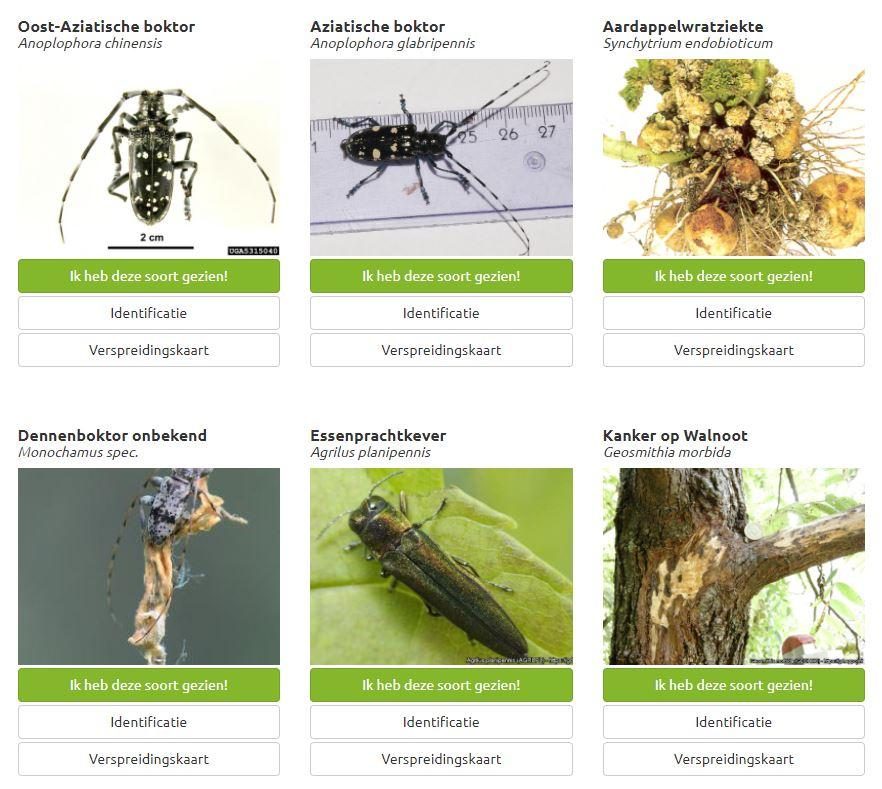Anyone who spots an unknown plant disease or pest in a garden or neighborhood can now identify and report the pathogen in the new Beware&Note application on the existing website waarnemingen.be. Flanders Research Institute for Agriculture, Fisheries and Food (ILVO), the Experimental Centre for Ornamental Horticulture (PCS) and Natuurpunt Study hope in this way to involve citizens in the protection of our public and private green spaces against alien diseases and pests. These so-called Q-organisms (with the Q from quarantine) are increasingly crossing the borders of the European Union, causing damage to our environment and food production.
 screenshot of the Beware&Note tool
screenshot of the Beware&Note tool
Your help is needed!
A plant disease or pathogen is branded as a quarantine organism (or Q organism) by EU legislation if it can cause major economic and ecological damage and no effective control measures are available. Therefore, the policy is doing its best to prevent the introduction and further spread of such organisms. One of the actions as part of this prevention, is the reporting of (suspected) introduction.
ILVO, PCS and Natuurpunt are now asking for help from nature volunteers, but also from gardeners, students, scientists and professionals in agriculture, horticulture and forestry to speed up this process. They can use the Beware&Note warning system to look up what they think they have seen. This can be about insects that are easily identifiable themselves or fungi, bacteria or viruses that cause recognizable symptoms. After identification, they can also report their find,' explains Wouter Vanreusel of Natuurpunt. 'In this way, the competent authorities and managers of forest, nature, agricultural and horticultural areas and plots can take action more quickly.'
Reports by private individuals on suspicious organisms have proved invaluable in the past: 'In 2006, for example, a bonsai enthusiast reported a peculiar beetle that he had found on a bonsai tree in Geraardsbergen. From the photo that he sent along it quickly became clear that it was an Asian longhorn beetle, a non-native beetle that can cause a lot of damage to all kinds of deciduous trees," says Jochem Bonte of ILVO. It had been imported together with the tree from Asia. The beetle and the tree were placed in quarantine, and fortunately no other eggs or larvae were found. In the Netherlands, in 2007 and 2009, a total of about 270,000 plants had to be destroyed after an outbreak of a similar Asian longhorned beetle species in residential areas. The quick reflexes of this citizen from Geraardsbergen prevented a lot of misery and expense.
How does the new app work?
Suppose, while on a hike, you find conifers with symptoms of dehydration and fungi on the trunk. You log on to Beware&Note and filter the database for pests on conifers.

You are given 2 suggestions, and you think it's the very aptly named fungus "pine killer" (Heterobasidion irregulare). On the accompanying sheets you will find an explanation of the symptoms caused by this fungus (in 3 languages) and a list of plant species that can be infected. If, after this explanation, you are convinced that it concerns the pine killer, you can report it with a simple tap and send a photo for inspection by an expert from ILVO or Natuurpunt. If you wish, you will be kept abreast of the further developments related to this observation. Each user can indicate in which crops and regions he or she is interested in, in order to receive notifications when a Q organism is found in that region.
Action only after the experts double-check
If we are not sure whether we can see a Q organism on your photo, we will take another sample at the same place,' Jochem Bonte explains. It is only after the experts are certain of the identification that the Federal Food Agency (FASFC), together with the possible owner or manager of the infected greenery, decides what measures should be taken. These can range from cutting down trees to destroying all crops within a certain perimeter. Hanne Denaeghel (PCS): "Because these emergency measures can be quite radical, it is crucial that each report of a Q organism is examined for authenticity, and only after verification by the experts and approval by the authorities can further steps be taken.
The new tool is thus an important element in the package of European measures aimed at curbing the introduction of alien diseases. The preventive approach, in particular intensive monitoring, rapid detection and control, should avoid high control costs and yield losses.
